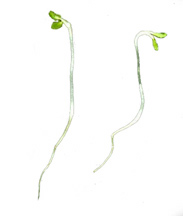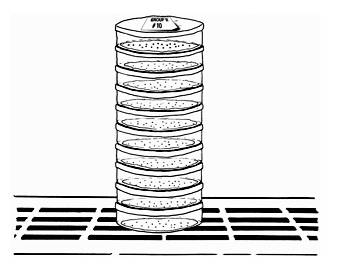
Seed Germination Lab Work (student)
Seeds are plants' way of reproducing. Each seed carries a plant embryo, wrapped in a casing or coat with its own food supply. Life functions in the seed are almost completely shut down until the time is right to start growing. But how does a seed know when the time is right? For you to answer this question, you must test the effects of different conditions on seed germination. One way is to germinate seeds in Petri dishes under very specific and controlled conditions. In this activity, you will investigate the effects of temperature and water.
A. Getting a Baseline: Petri Dish Preparation
The instructions below will help you prepare Petri dishes of seeds.You want lots of dishes so you can do multiple experiments, run each experiment more than once, and look for the natural variation in the number of seeds that germinate. Gather all the necessary materials. The number of Petri dishes you want to prepare will depend on the availability of materials, the time given for dish preparation, and the requirements of your experiment. In general, however, the more dishes you have, the better your experiments will be.
Materials
- Seeds
- Petri dishes
- Paper towels
- Tweezers
Procedures
- Wash your hands carefully to reduce any contamination.
- Cut the paper towels into round circles that will fit inside the bottom of the Petri dishes.
- Moisten the circular pieces of paper towel with as much water as they can absorb.
- Wipe off excess water droplets.
- Place one paper round into the bottom of each Petri dish.
- Using tweezers, count exactly 20 seeds onto a paper towel. Handle the seeds very gently.
- Have a partner recount the seeds to make sure there are 20, as the seeds are very small.
- Using tweezers, very gently place the 20 seeds into a Petri dish.
- Place the covers securely on the Petri dishes. (An improperly secured cover will let air into a Petri dish and, therefore, change the growing conditions.)
- Using the identical procedure, count and place 20 seeds into each of the remaining Petri dishes.
- Store the Petri dishes where they will not be disturbed for 24 to 48 hours. Keep them at room temperature (20–23 deg.C), away from heating radiators and out of direct sunlight.

B. TESTING TEMPERATURE CONDITIONS
Making a Hot Temperature gradient
In this experiment, you are investigating whether or not temperature affects seed dormancy and germination. The idea is to expose seeds to many different temperature conditions and then measure the number of seeds breaking dormancy at each temperature. If temperature does not affect breaking dormancy, then the same number of seeds should break dormancy under all temperature conditions. If temperature does affect breaking dormancy, then a different number of seeds should break dormancy under each temperature condition.
Materials
- Alfalfa seeds
- Petri dishes
- Paper towels
- Water droppers
- Distilled water
- Tweezers
- Hot surface area (prepared by your teacher)
Procedures
- Prepare Petri dishes of seeds as described earlier.
- Add the same amount of water (about one dropper full) to each Petri dish. The bottom of the Petri dish should be just beginning to show non-absorbed water. Replace the lid on each dish.
- Create stacks of 10 Petri dishes.
- Carefully label the dishes so you know which dishes belong to your team. If you have more than one stack of 10 dishes, label the stacks so you can tell them apart.
- Label each Petri dish so that you know exactly where in each stack that Petri dish belongs. (For example, Dish 1- Bottom, Dish 2, ..., Dish 10- Top)
- Move your stack(s) of Petri dishes to the hot surface. Make sure your dishes are in the correct order and the stacks are steady.
- Let the Petri dishes of seeds sit for 24 to 48 hours (1 to 2 days).
- Record your exact procedures and your predictions for the experiment in your GL Journal.
What Have You Done?
You have exposed seeds to many different temperature conditions. By stacking your Petri dishes on a hot surface, you have created a hot temperature gradient. The Petri dish on the bottom of the stack is very hot, the next dish up is hot, but not as hot as the bottom dish, and so on. The temperature continues to drop as you move up the stack, with the top dish in the stack being the most cool.
C. TESTING WATER CONDITIONS
Making a Moisture Gradient
Materials
- Alfalfa seeds
- Petri dishes
- Paper towels
- Water droppers
- Distilled water
- Tweezers
Procedures
- Prepare Petri dishes of 20 seeds each as described earlier.
- Line up a row of 10 Petri dishes with seeds.
- Carefully label the dishes so you know which dishes belong to your team. If you have more than one row of 10 dishes, label the rows so you can tell them apart.
- Label the first Petri dish in each row with a 0, the second dish with a 5, the third dish with a 10, and so on by 5s. When you are done, you should have dishes 0, 5, 10, 15, 20, 25, 30, 35, 40, and 45.
- Add drops of water to each dish according to the label on the dish. For example, in the dish labeled 0, do not add any water; in the dish labeled 5, add 5 drops of water; in the dish labeled 10, add 10 drops of water; and so on. Replace the lid on each dish.
- Place the dishes in a location where they will not be disturbed.
- Let the Petri dishes of seeds sit for 24 to 48 hours (1 to 2 days).
- Record your exact procedures and your predictions for the experiment in your GL Journal.
What Have You Done?
You have exposed seeds to many different water conditions. By adding a different amount of water to each dish, you can test how much water seeds need to germinate. If water does not affect breaking dormancy, then the same number of seeds should break dormancy under all water conditions. If water does affect breaking dormancy, then a different number of seeds should break dormancy under different water conditions.




![]()